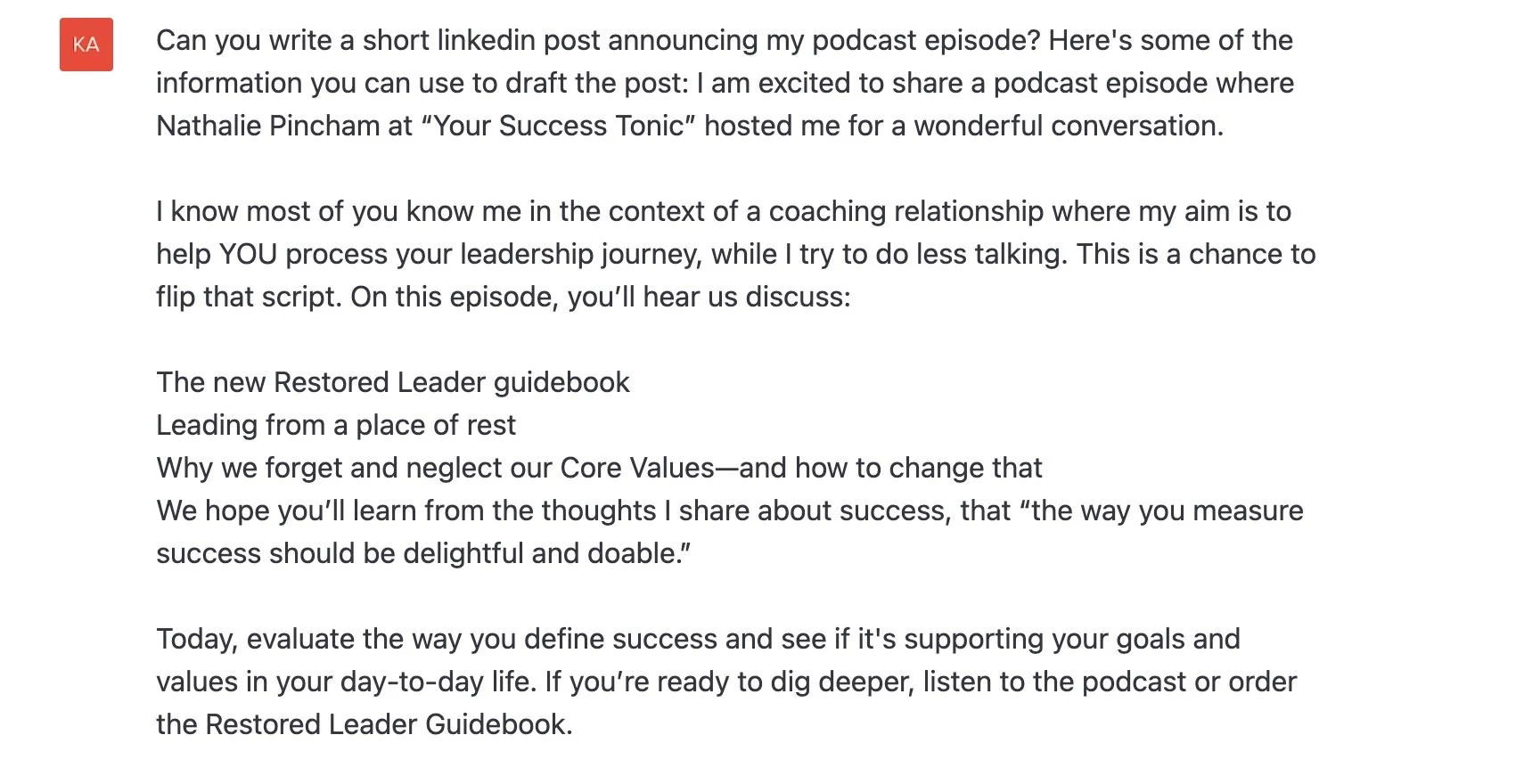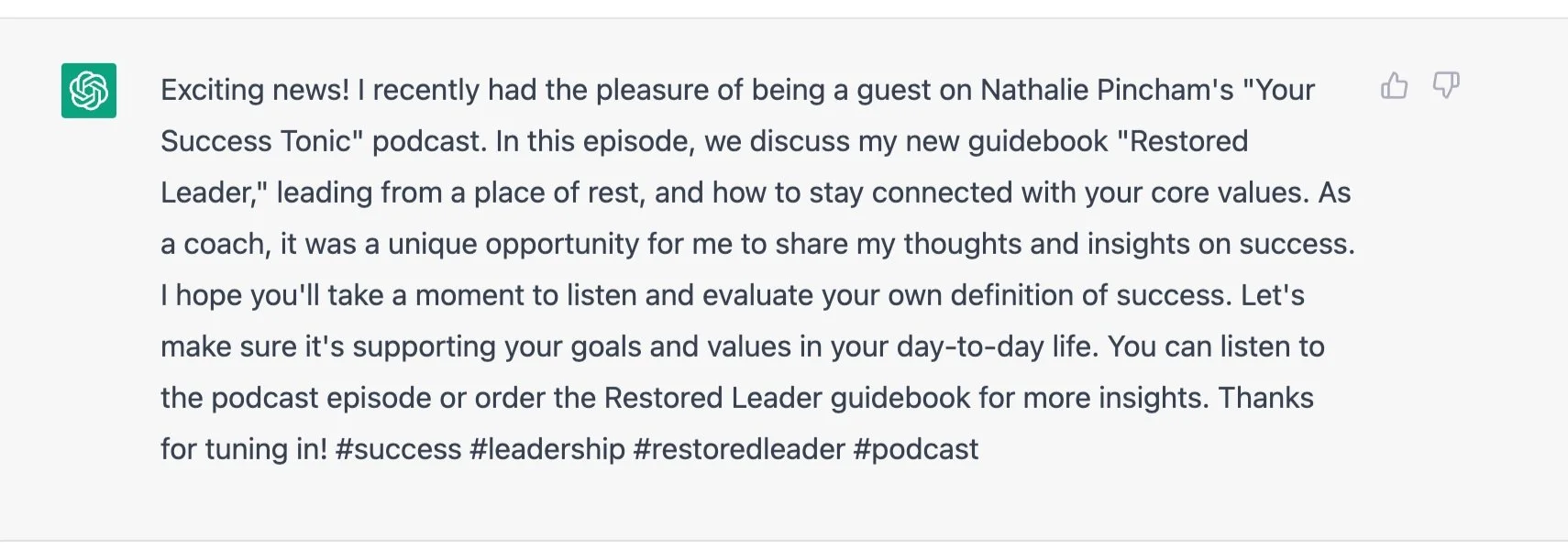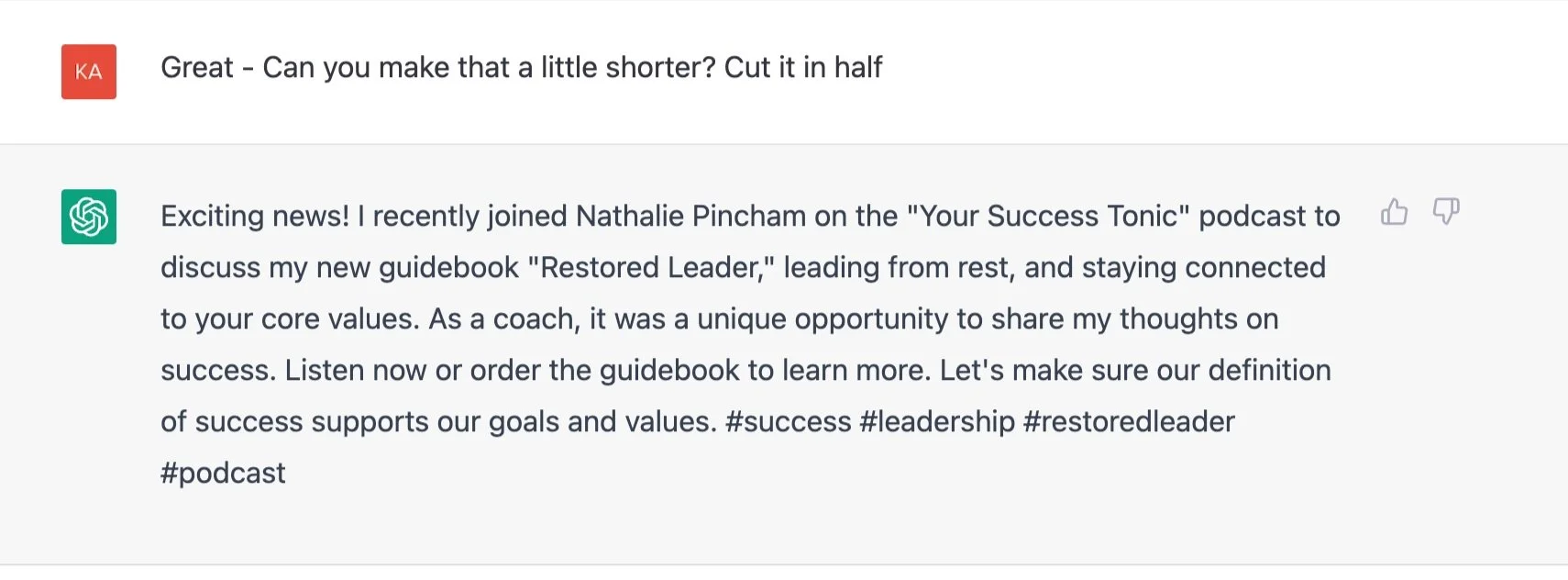A Chat GPT Case Study
May 8, 2023
We’re at it again, talking about ChatGPT. But hear us out! This isn’t another blog philosophizing over what ChatGPT means for the future and how we should respond as writers (we already wrote one on that topic, if you’re interested…)
ChatGPT and all of its AI counterparts are out in the world, and it’s going to stay that way. It’s important to be able to think at a high level about ChatGPT, but it’s also important to know how to actually use ChatGPT for the good of your business.
Our founder Katie was recently on the Marketing Made Simple Podcast, where she shared a practical example of an instance where she used ChatGPT in an everyday scenario.
Let’s dive in to that example and see what it can teach us:
The prompt
Using ChatGPT to generate new content is a gamble – it’s great for getting unstuck with writer’s block or just waiting for inspiration to strike, but we also love how Katie used it here – to repurpose content! She didn’t need a brand new piece of content written, but she also didn’t want to spend too much time mulling over how to format this LinkedIn post. Enter, ChatGPT:

Katie needed to repurpose the email content she wrote for our client, The Restored Leader, and turn it into a LinkedIn post. The key thing that Katie did to give ChatGPT a strong start was to provide sufficient background information.
Asking an AI to “write instructions for cooking chicken” will likely produce an accurate, yet simple result – and sometimes that’s just what you need.
But most of us aren’t writing instructions for cooking chicken – we’re navigating complicated topics for a particular audience. Using ChatGPT to write content for a business that already has a distinct voice can lead to a lot that gets lost in translation.
If Katie had prompted ChatGPT by saying, “Write a LinkedIn post promoting The Restored Leader’s new guidebook.” It would be a long process to get the responses anywhere close to the target.
Let’s take a look at the response Katie got:
The response

The first draft ChatGPT created from Katie’s prompt was a good start! ChatGPT was able to keep the prompt’s core points but made it a bit more conversational for the LinkedIn format.
It still needed some work though:
The feedback

Since this post was going up on a page that doesn’t frequently post in LinkedIn, Katie knew it needed to be short and sweet. So she asked for it to be cut in half. This is another great use for ChatGPT – if you can’t figure out what to cut but you really need your content to be less wordy, let ChatGPT serve you by condensing and cutting content for you.
Katie could have kept refining this draft by giving ChataGPT nitpicky instructions, but that would have actually wasted time and energy instead of saving time. This AI got the draft started, and Katie knew it was her job to really polish it:
The final product
“I had the privilege of joining Nathalie Pincham on the “Your Success Tonic” podcast to discuss the vital role that Core Values play in everything you do as a leader.
In our 25-minute conversation, we discuss what it means to lead from rest and how to stay connected to your Core Values as a leader.
Link to podcast
#success #leadership #therestoredleader #podcast”
ChatGPT shortened its original draft, but the post still needed to be shorter. Katie edited it out into smaller paragraphs and provided a bit more context about the podcast to get listeners interested.
On the podcast, Katie points out that it was necessary for her to go back through and make small edits that ChatGPT doesn’t have a way of knowing are necessary, because they’re company-specific. For example, “Core Values” wouldn’t typically be capitalized, but all of TRL’s content capitalizes that phrase.
And there you have it! A simple, effective post that ChatGPT gave a leg-up to along the way.
There are a lot of conversations about the huge, crazy things ChatGPT can and will do. While we fully believe those things are possible, we’re more interested in using ChatGPT to aid us in these small ways while still remaining our own primary content creators.
As we see it, this “use it when it’s useful” approach is the best way forward in a world where we’re learning to coexist with AI. The bottom line is that if ChatGPT feels stressful or scary to you, don’t overthink it. Play around with how it can serve you in the most effective ways, and move on.
If you don’t want to create all of your own content, but you also don’t love the idea of a robot creating it — we might be the perfect middle ground. Whether you’re interested in website content and development, blog writing, or lead generation, we’d love to help!
P.S.
We want to be totally transparent when it comes to our use of AI. We’ve blogged about it some already, but here’s our full take:
How Murphy Marketing uses AI writing tools:
Through the lens of our overarching Core Value of Unity, our aim for every client is to help support them reach their goal.
To achieve this, we will sometimes use an AI writing tool to:
-
Kick-start ideas for content
-
Help us get “un-stuck” on ways to phrase a concept or ideas
-
Produce a first draft outline for a piece of content
We will never use an AI tool to write a “final draft” of any content – blogs, emails, social posts, website content. We will always be too proud and care too much to rely solely on a robot to do our work.